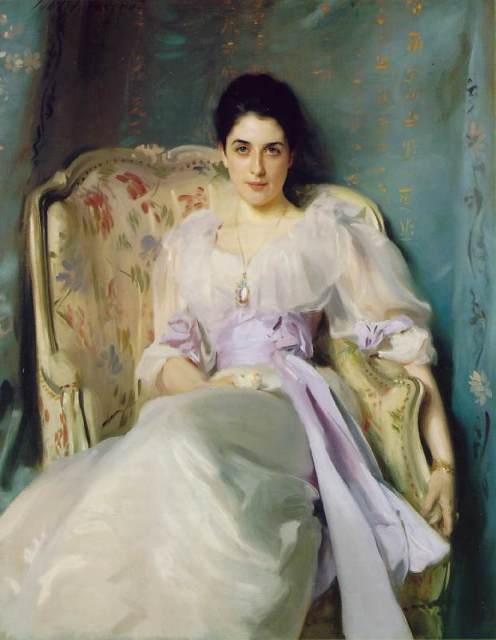John Singer Sargent’s Lady Agnew of Lochnaw, 1892-93
I will be dedicating this portion of my blog to analyzing the fashion and gaze in paintings from the turn of the twentieth century.
Let’s start with a painting shown in my art history class during the first couple days that really resonated with me.
This is a portrait of Lady Agnew of Lochnaw, painted by American artist John Singer Sargent, dated 1892-93. When I first saw this painting, I was instantly captivated by it, though I wasn’t really sure why. But once you let yourself get lost in her gaze and observe the poise in her posture, you begin to understand why it’s so alluring.
Gaze: Artists like to use the visual sense as a form of communication, and this painting does not disappoint. Looking into her eyes, one sees power and intellect. This look of intelligence mingled with a sense of self-assurance does not in the least bit appear insincere, but rather seems to portray her true inner beauty. Though there is a stark cleverness and attractiveness to her of which she is clearly aware, her physiognamy is not overwrought in these attributes to the point of appearing manipulative or sexually suggestive. This young female appears confident not cocky, beautiful not erotic, and assertive not dogmatic.
Moreover, though there is an intensity in her gaze, she is not staring at the viewer. The latter tends to have a negative connotation; after all, an individual who appears to be staring at you will probably make you feel uneasy and uncomfortable.
For example, the following is a random image of a modern day man that popped up after typing “man staring” on Google Images:
Contrast this with an individual directly gazing at you, which tends to be more sensual and less contrived.
For example, below is an image of another man that came up on Google Images after typing “man gazing”:
In case you were interested, typing “man staring” showed mostly scary or perverted facial expressions whereas “man gazing”showed mostly men softly looking into the camera.
All in all, both the stare and the gaze involve one looking at something/someone, but the latter evokes a more sensual feel that is comforting, not disrespectful or frightening.
Despite it being only one glimpse at Lady Agnew of Lochnaw, as the saying goes, this picture, in my opinion, is worth “a thousand words,” and it is being told mostly by her captivating eyes. I think the reason this picture caught my eye is because the person she genuinely appears to be, i.e., a strong, intelligent and beautiful woman who is comfortable in her own skin, is someone whose qualities I particularly admire.
Stay tuned for the next post, where Lady Agnew of Lochnaw’s fashion attire will be analyzed to further reveal the kind of person she was as well as to understand the goals of the artist in choosing the style of dress, hair and accessories for Lady Agnew.




I like how you could have made a most wanted post using those faces you searched up haha. All kidding aside, I think that the artist challenges viewers to imagine and conduct stories of the subject’s life, her feelings towards herself and others, and her status all through her body language and gaze. When looking at this painting a number of times, I still find it amazing that the gaze is so strong and somewhat real.
Hope you liked them:)
I like the point you made about the artist’s goal to create a sort of “biographical” portrait panting- one that illustrates a person’s life and personality. John Singer Sargent’s objective in his paintings was to paint accurate depictions of reality, even if t was at the expense of clientele (In my next post, I added a response letter he wrote to the husband of an unhappy client). I think in this painting he us to capture in Lady Agnew a sophisticated, bright and attractive young woman with an undertone of a little energy and zing! It’s in the subtle smirk in her lips.. and doesn’t it almost look like she’s give us a very toned down version of the “smize” (smiling with the eyes, a phrase coined by Tyra Banks)?
I agree, her gaze is…glorious. But There are other features which help support her “empowered” charisma. Her posture, particularly her hand at the side of the chair, show she is at ease, and is almost in command of the chair. She is sitting in the chair at an angle (which is angled), so her torso is parallel to us but her lower body is at a diagonal–diagonals are powerful tools in art, and convey energy and dynamism. She has very upright posture, but her back is against the back of her chair, which seems to suggest she is not concerned by the trivial societal expectations of propriety–that she is above that.
She also has an air of sophistication from the hanging oriental drapery and her dress. She could easily stand, and seem like the perfect society lady of 1892.
Thanks, that was insightful. This blog analyzes only fashion and gaze, so I try not to discuss anything else just to keep it focused, but thanks for the insight! I enjoyed reading what you said about diagonals; I could sense that zing in her from the get-go, but couldn’t quite figure out why, besides attributing it to her gaze. You explanation makes a lot of sense and it’s interesting cause it looks at things from a different more subtle perspective!